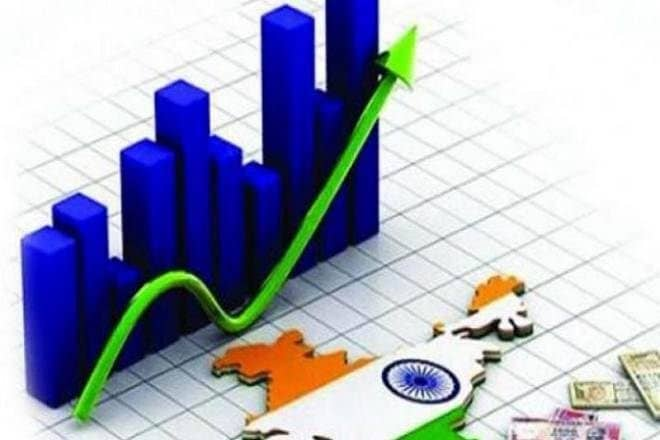China has just celebrated the 70th anniversary of the Communist takeover in 1949. It boasts that it grew by 8.1% per annum on average over 1952-2018. This comes to an increase of income 54 times its value in real terms in 1952. China’s income didn’t grow steadily each year at 8%. It grew at just the same rate as India for the first 25 years after 1950. In 1975, India and China had the same per capita income. China’s growth began after Deng Xiao Ping reversed the Mao-era policies that had not just crashed the economy, but cost 50 million lives by then. China’s growth happened in the last 20-25 years.
The CAGR has to be ~twice 8.1% to achieve that.
Now, compare India. Over 70 years since 1950, India increased its income by 28 times. India grew at around 3% for the first 30 years, 1950-1981. Then, the growth rate stepped up to about 5% for the next 22 years. It is in the last 15 years, 2003-2018, that the growth rate went up to 7.7%. In those last 15 years, income grew four times. Thus, in the first 40 years, it grew seven times, and, then, in the last 15, four times. Such is the magic of compound growth numbers.
Look at India’s experience in the three phases. The first phase of 1950-1981 is dismal. India pursued import substitution. This meant not benefiting from foreign trade and not letting its cotton textile industry increase exports. Industrialisation was capital intensive. Agriculture was neglected on the idea that the problem was redistribution of output from landlord to tenant and not of growth or productivity.
It was a disaster. The long-run, secular effects of this strategy is that we still have far too many people living in agriculture with two-thirds of the farmers practising subsistence-level agriculture. Agriculture has not grown even as fast as 5% on average for five years at a stretch. While there is a lot of romanticism about the kisan, agriculture is the biggest obstacle to achieving high growth rates.
The most urgent need is now to help farmers to move out of agriculture and into some other activity which can afford them a better livelihood. Subsistence-level farmers already rely on non-agricultural activity to supplement their incomes, as a Nabard survey shows. Instead of giving farmers `6,000 and having them stay on the farm, the Centre should be give a substantial sum to leave farming.
In the second phase, 1981-2003, a sort of realism crept in. The economy crashed due to the oil price shock. Indira Gandhi abandoned self-sufficiency and took a large loan from the IMF. Rajiv Gandhi began borrowing money from abroad (from NRIs). He liberalised imports, though he didn’t reform the industrial economy to increase exports. The economy crashed again, and, in 1991, another emergency loan had to be taken.
This taught India that it had to borrow abroad to grow. It had to let its economy to benefit from international trade. So, in 1991, PV Narasimha Rao liberalised the economy, cutting tariffs and abolishing quotas. The growth rate increased to around 5%, higher than the 3% previously, but was still inadequate. Still, neoliberalism was denounced by the Left in the Congress and outside.
The Vajpayee government, in the last five years of this period, began to free the government policy from blind faith in state-ownership. Slowly, it began to divest. The big delusions of the first generation of economic planners—import substitution, neglect of agriculture, self-sufficiency and state-ownership—were abandoned, though very unwillingly. Vajpayee’s was the first government that dealt with international trade and capital movements in a grown-up manner.
The stage was set for the third and latest act. India prepared itself to thrive as an open economy. Luckily for India, there was a global macroeconomic boom from 2003 to 2008, and, after a crisis, enough countries reflated to avoid a severe depression. This helped India.
So, what is next? The first step is to have an ambitious programme to transfer farmers out of farming to other jobs. The government could make it a condition of debt cancellation that the debtor farmer would quit agriculture. The second task is to abandon the preference for state-ownership. It was always an economic folly whichever political label it carried. It was the biggest waste of scarce money in a desperately poor country to flatter the egos of an elite. A large-scale sale of state-owned enterprises is urgent. The BJP has no investment in the ideology of Fabian- or Soviet-style socialism that Congress had. Modi 2.0 can erase all the surviving obstacles to rapid growth that Nehru-Gandhi put in place.
Modi 1.0 began to build a comprehensive welfare state with Swachh Bharat, Ayushman Bharat, electrification, pension schemes which cover the workers in informal sector, farmers and the elderly, etc. The time has come to give it a rounded shape and dig deep foundations for it.
Whether income gets to $5 trillion or not by 2024 is irrelevant. What matters is that each year is better than the last.
(The writer is prominent economist and labour peer. Views are personal)


